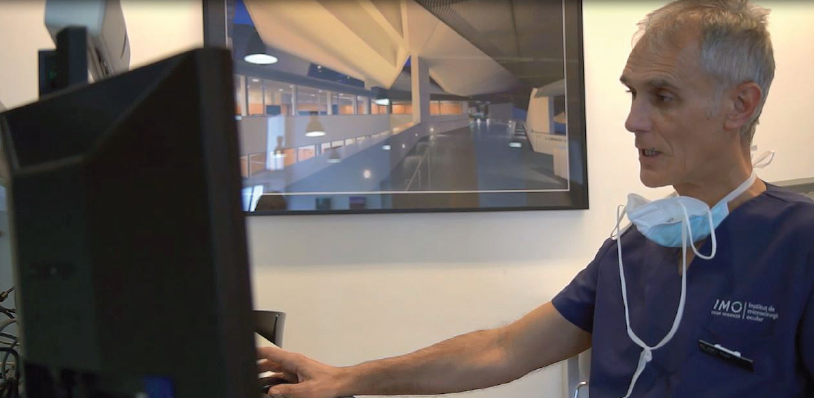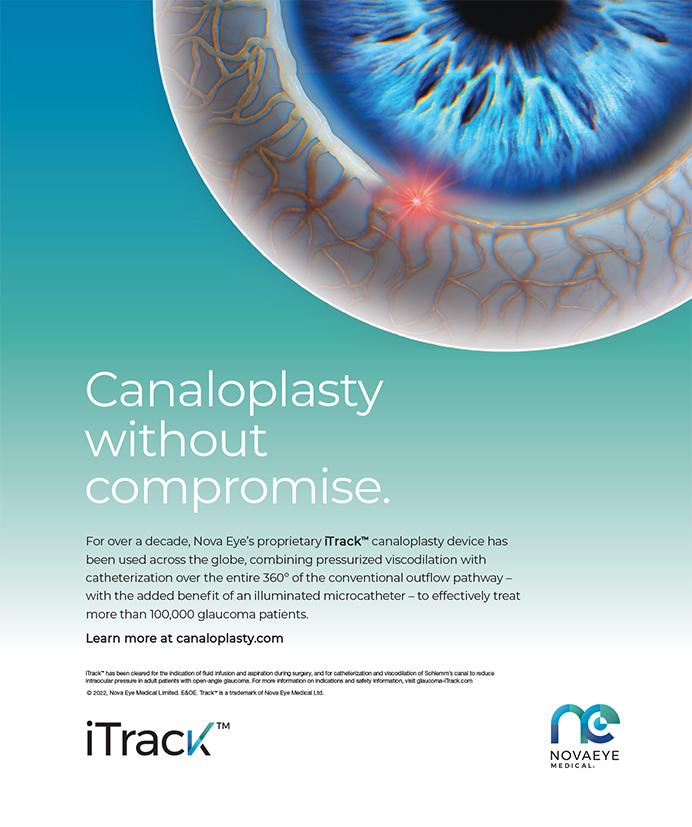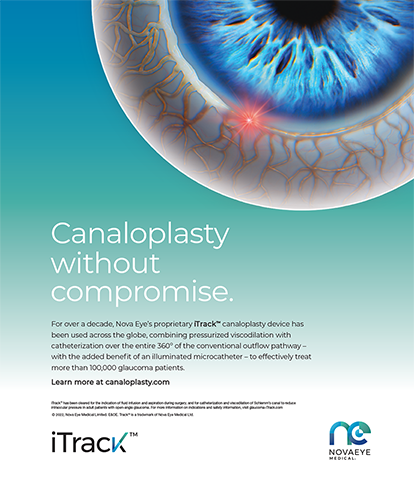Increasing Access to Care

José L. Güell, MD, PhD
Barcelona, Spain
At IMO Grupo Miranza, we aim to provide the best ophthalmologic service to as many patients as possible. The use of telemedicine allows us to make our expertise accessible to more patients.
CRITERIA
We offer teleconsultations to three categories of patients.
No. 1. Those who need a medical opinion but prefer not to travel or who cannot travel to our clinic.
No. 2. Those who need a follow-up appointment with their doctor. For patients in this category, test results and measurements from an optometric evaluation have already been obtained. In my field of corneal transplantation, this kind of follow-up appointment is particularly important in order to reduce the risk of undertreatment and possible transplant rejection.
No. 3. Those seeking a second opinion. These individuals have a diagnosis and test results from another clinic that have been shared with us.
THE TELECONSULTATION PROCESS
Step No. 1: Preparation. I study the patient’s history and evaluate past medical reports or test results (if available) in preparation for the session.
Step No. 2: The patient interview. At the start of the appointment, patients describe their symptoms and the reason for the consultation (Figure).

Figure. Dr. Güell conducts a telemedicine appointment.
Courtesy of José L. Güell, MD, PhD
Step No. 3: Family history. I usually ask about the family history, current diseases, and other relevant factors.
Step No. 4: Diagnosis and treatment. With the information I have gathered, I am able to offer a tentative diagnosis or recommendations for follow-up or treatment of the problem. Sometimes, the recommendation is to schedule an in-person consultation. It is important to note that prescriptions can be sent by email after a teleconsultation.
CONCLUSION
Telemedicine is a convenient tool that we use to help a greater number of patients. The COVID-19 lockdowns increased demand for teleconsultations, but the volume of these appointments has remained high at our center. I think that the convenience, cost-effectiveness, and efficiency of telemedicine are the keys to its popularity and that teleconsultations will remain a part of our center’s health care offerings because of these benefits.
It is important, however, for doctors and patients to understand the limitations of telemedicine. Patients must be educated about symptoms that warrant an emergent (in-person) visit.
Accessibility, Scalability, and Patient Empowerment are Keys to Success

Josef Huemer, MD, FEBO
London
The COVID-19 pandemic facilitated telemedicine projects across all medical specialties during countrywide lockdowns and in response to travel restrictions and social distancing measures. Several questions must be addressed in the establishment of this service:
- How can patient safety be guaranteed;
- How can the patients who need to be seen in person be identified;
- How many nonurgent cases can be managed virtually;
- How can patients who lack access to digital technologies be managed; and
- How can patients be empowered to monitor themselves with validated applications?
VIDEO CONSULTATIONS
Video consultations are at the center of many telemedicine projects. The accidents and emergency department at Moorfields Eye Hospital reported that, within the first 12 days of implementing a video consultation drop-in service, nearly 80% of patients could be managed using this platform alone with advice, remote prescriptions, a subspecialty referral, or a referral to a general practitioner. If advice from a senior consultant was required, the accidents and emergency doctors communicated through a secure instant messaging application to ensure data security.1 Clinicians had access to electronic medical records, scanned paper notes (if available), and detailed guidance on red flags that necessitated physical attendance. Importantly, patients were informed that a video consultation did not replace a full ophthalmic examination and was mainly for triage purposes.2
Synchronous video consultation studies conducted in neuro-ophthalmology and oculoplastics demonstrated cost efficiency and safety, especially when clear guidance was provided on how to assess patients.3,4 Notably, 92% of patients participating in the Moorfields oculoplastics study said they would recommend video consultation to others.
Asynchronous store-and-forward models may be more suitable for imaging-dependent disciplines such as medical retina. Imaging hubs and technician-led virtual clinics have rapidly adapted to mandatory social distancing measures and are expected to play a big role in postoperative follow-up after the current pandemic. Virtual clinics can improve the patient journey significantly because they offer faster turnaround and provide a safe environment for patients who do not require urgent care.
REMOTE CARE
Not all of the available applications to test visual acuity, color vision, and visual fields have been validated, so it is important to know the limitations of each test when using it in clinical practice.
For patients with limited access to technology, standardized home-printable screening tests can be sent to patients before a scheduled telephone appointment.5 Together with unique test identifiers, clear instructions, a blue tag, and a 1.5-m precut cord to ensure the correct reading distance, such tests provide high repeatability and a truly low-tech approach.
For patients at risk of severe vision loss from retinal disease, home OCT is a promising concept currently being investigated.6 The FDA-approved home monitoring apps using hyperacuity testing for the central 12º of the macula are available for smartphones using iOS and Android. Real-world data from Singapore assessing the Alleye app (Oculocare Medical) identified difficulties with self-monitoring initiatives such as patient recruitment and offered guidance on the creation of programs after the COVID-19 pandemic subsides.7
LOOKING FORWARD
Three factors will be key to the continued use of telemedicine after the current pandemic:
- Accessibility for both caregivers and patients;
- Scalability to accommodate the long waiting lists that will be part of the clinical routine; and
- Patient empowerment in the form of home monitoring to provide personalized care.
1. Kilduff CLS, Thomas AAP, Dugdill J, et al. Creating the Moorfields’ virtual eye casualty: video consultations to provide emergency teleophthalmology care during and beyond the COVID-19 pandemic. BMJ Health Care Inform. 2020;27(3):e100179.
2. Gillam M, Li J-PO, Kilduff CLS, et al. Teleophthalmology consultations—how do we keep our patients safe? Eye (Lond). 2021;35(4):1043-1044.
3. Lai KE, Ko MW, Rucker JC, et al. Tele-neuro-ophthalmology during the age of COVID-19. J Neuroophthalmol. 2020;40(3):292-304.
4. Kang S, Thomas PBM, Sim DA, Parker RT, Daniel C, Uddin JM. Oculoplastic video-based telemedicine consultations: Covid-19 and beyond. Eye (Lond). 2020;34(7):1193-1195.
5. Crossland MD, Dekker TM, Hancox J, Lisi M, Wemyss TA, Thomas PBM. Evaluation of a home-printable vision screening test for telemedicine. JAMA Ophthalmol. 2021;139(3):271-277.
6. AREDS2-HOME Study Research Group, Chew EY, Clemons TE, et al. Randomized trial of a home monitoring system for early detection of choroidal neovascularization home monitoring of the Eye (HOME) study. Ophthalmology. 2014;121(2):535-544.
7. Chong Teo KY, Bachmann LM, Sim D, et al. Patterns and characteristics of a real-world implementation of a self-monitoring program for retina diseases during COVID-19 pandemic. Ophthalmol Retina. Published online February 18, 2021. doi:10.1016/j.oret.2021.02.005
In our Perspective, Teleopathalmology is useful


By Abhay R. Vasavada, MS, FRCS, and Vaishali Vasavada, MS
Ahmedabad, India
Since the COVID-19 pandemic hit this past year, our lives and practices have encountered challenges and, therefore, have gone through changes. One trend that we feel is positive and here to stay is the expanding use of telemedicine in ophthalmology. Before the pandemic, our practice revolved around physical consultation and management. Like most clinics globally, however, ours came to rely on technology to help avoid gaps in our patients’ care.
ADVANTAGES OF TELEMEDICINE
Communication. First and foremost, telemedicine allows clinicians and practices, in general, to stay in touch with patients. In our opinion, this offers a huge comfort factor to patients who require long-term care such as pediatric and post–corneal transplant patients and those with diabetes and/or glaucoma. Detailed examinations such as fundus photography, IOP readings, and slit-lamp assessments are not yet common with telemedicine consultations, but applying simple screening tests such as visual acuity, anterior segment evaluations, and assessments of patient complaints can help triage patients into two categories: those who need urgent physical attention and those who can be managed remotely.
Reduced anxiety. With the emergence of multiple waves and mutatations of the SARS-CoV-2 virus in different geographical locations, people face the challenges of lockdowns and movement restrictions that can disrupt the continuity of care. In these scenarios, having a point of care and contact via telemedicine can help reduce morbidity, the cost of care, and vision loss. An intangible benefit of telemedicine is the reduction in anxiety among patients during these challenging times.
Lower costs. Incorporating telemedicine into routine practice can reduce costs for both patients and the practice while regulating the number of patients physically attending clinics. This becomes especially important in high-volume practices where maintaining distance between patients may not be possible. In such situations, telemedicine visits are a convenient and cost-effective option for some patients. Telemedicine appointments can also save time for patients and their accompanying caregivers.
THE MOTHER OF INVENTION
When the pandemic was in its active phase, we had several patients with COVID-19 who were quarantined at home. Many of them experienced ocular problems during illness and recovery phases. Telemedicine was particularly valuable to triage these patients and identify those who might have vision-threatening problems. The pandemic has made us aware of the many possibilities that telemedicine offers, and its use will undoubtedly continue to expand to include new opportunities.
We strongly believe telemedicine will remain an important parallel arm in patient care even when the pandemic subsides. A combination of physical visits and telemedicine can be synergistic and help patients access health care from any area and in any situation. We are also hopeful that there will be innovations that allow patients to be evaluated in greater detail with greater accuracy and ease.
There are several challenges that patients and practices face in adopting telemedicine on a larger scale. First, there is a learning curve that both parties must negotiate. Patients’ geographical location, education level, access to a smartphone, internet connectivity, and ability to use complex interfaces can all present difficulties. Telemedicine also requires a shift in the mindset of the consulting ophthalmologists and technicians. Lastly, the legal framework regarding patient data, liability, and consent is not well defined worldwide.
Necessity is often the mother of invention. Teleophthalmology is not new, but its adoption and utility have increased during the pandemic. In our practice, it has now become an important tool, especially for maintaining a continuum of care in patients with chronic eye diseases and in screening and triaging patients.
As telemedicine platforms and options continue to evolve, they will become an integral part of ophthalmic care in most parts of the world.
There Are Many Indications for Telemedicine

Blake K. Williamson, MD, MPH, MS
Louisiana, United States
In the height of the COVID-19 pandemic, the doctors and staff at Williamson Eye Center relied heavily on telemedicine to provide patients with some level of care. We continued to perform certain examinations remotely, we answered patients’ questions, and we refilled prescriptions. Telemedicine kept our practice alive in triaging, communicating with patients, and helping those with eye emergencies.
As we returned to in-person care, however, the need for telemedicine was not as pressing. We took a close look at how we could continue using telemedicine in a meaningful way for our practice and our patients. We now use telemedicine in two main ways that help to build our practice and create efficiencies that weren’t there before the pandemic.
CURRENT USES
No. 1: Postoperative evaluations. All of our day 1 postoperative follow-up visits for routine cataract surgery patients are now done via telemedicine. We do not, however, schedule telemedicine appointments for patients in whom a complication occurred or MIGS was performed. I typically start my day with about 30 postoperative day 1 telemedicine consultations. I examine the eyes and ask patients the appropriate questions. It is a time-saver for my staff, and it reduces the number of patients who are in the clinic on a given day. I can see 30 day 1 postoperative patients in about 30 to 45 minutes, and I can do it remotely. That opens up 30 slots on the clinic schedule for new patients.
No. 2: LASIK consultations. Our refractive counselors now use telemedicine for the initial LASIK consultation. Prospective patients can book a consultation directly on our website. This approach has increased the number of in-person consultations we book because it is a more personal approach compared with a telephone call or an email.
CONCLUSION
People are more comfortable with telecommunication now than ever before. Remote work and meetings on platforms such as Zoom have increased patients’ comfort level with communicating from a distance. Telemedicine will never replace in-person surgical consultations, but it will continue to be a useful adjunct.




